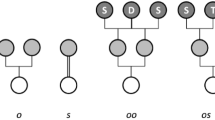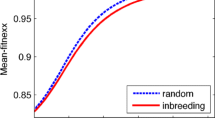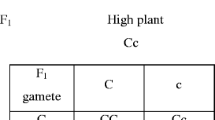Summary
Response to individual selection under random mating and under selfing in the progeny of a cross of homozygous parents is studied by means of computer simulation. The effects of environmental variation, the number of loci involved and the degree of linkage are described. The results predict that the short term effect of intermating is negligable in general. In the long run, random mating is superior to selfing, expecially when many loci are involved.
Similar content being viewed by others
References
Baker, R. J., 1968. Extent of intermating in self-pollinated species necessary to counteract the effects of genetic drift. Crop Sci. 8: 547–550.
Bos, I., 1977. More arguments against intermating F2 plants of a self-fertilizing crop. Euphytica 26: 33–46.
Hanson, W. D., 1959. The breakup of initial linkage blocks under selected mating systems. Genetics 44: 857–868.
Karlin, S., 1968. Equilibrium behavior of population genetic models with non-random mating. Gordon and Breach, New York.
Nelder, J. A., 1952. Some genotypic frequencies and variance components occurring in biometrical genetics. Heredity 6: 378–394.
Pederson, D. G., 1974. Arguments against intermating before selection in a self-fertilizing species. Theor. appl. Genet. 45: 157–162.
Author information
Authors and Affiliations
Rights and permissions
About this article
Cite this article
Stam, P. Selection response under random mating and under selfing in the progeny of a cross of homozygous parents. Euphytica 26, 169–184 (1977). https://doi.org/10.1007/BF00032082
Received:
Issue Date:
DOI: https://doi.org/10.1007/BF00032082




